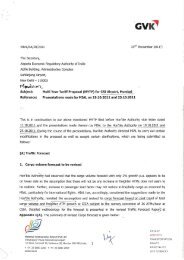Association of Private Airport Operators(APAO - AERA
Association of Private Airport Operators(APAO - AERA
Association of Private Airport Operators(APAO - AERA
You also want an ePaper? Increase the reach of your titles
YUMPU automatically turns print PDFs into web optimized ePapers that Google loves.
<strong>Association</strong> <strong>of</strong><strong>Private</strong> <strong>Airport</strong> <strong>Operators</strong><br />
Response to <strong>AERA</strong> 's Consultation Paper No. 32/2011-12 tit. 03 Jan 2012 Oil<br />
determination <strong>of</strong>A eronautical Tariffill resoect <strong>of</strong>IGI Airoort. New Delhi<br />
markets have similar risk as Indian <strong>Airport</strong>s. The rationale provided by NIPFP for<br />
including airports from developed as well as emerging markets is:<br />
29tl1 February 2012<br />
"In terms <strong>of</strong>traffic volume, all the private airports in India have grown very fa st and<br />
they are now mostly comparable with airports in developed countries. This is<br />
substantiated by the surveys <strong>of</strong> <strong>Airport</strong>s Council International (ACI) (www.aci.aero),<br />
the representative body <strong>of</strong>the airports, which has rated the Hyderabad airport as the<br />
best in the world in the category <strong>of</strong> airports in the 5-15 million category for the year<br />
2010. Similarly, Mumbal airport and Delhi airport have been rated the 2nd best and<br />
dth best in their respective categories (Mumbai -15 to 25 million and Delhi -25 to 40<br />
million). "<br />
3.9 India, as a result <strong>of</strong> its large population, has similar traffic volume as some other<br />
airports in developed countries. However, traffic volatility and underlying factors <strong>of</strong><br />
traffic growth (such as per capita income, GDP growth rate, and income and price<br />
elasticity) in these developed countries are different from those in India, which is an<br />
emerging market. Thus, riskiness <strong>of</strong> airport assets in India is higher than those in<br />
developed markets.<br />
3.10 ACI rankings primarily reflect service quality <strong>of</strong> airports and are not a measure <strong>of</strong><br />
riskiness <strong>of</strong> an airport asset. On the contrary, the stringent quality norms for Indian<br />
<strong>Airport</strong>s as specified under OMDA and <strong>AERA</strong>'s tariff guidelines have necessitated<br />
capital expenditure to maintain minimum service quality levels and thus increase<br />
riskiness <strong>of</strong> the assets because <strong>of</strong> higher operating leverage.<br />
3.11 Unlike airports in developed markets which are mature assets, Indian private airport<br />
operators are still at a nascent stage and are confronted with various business risks and<br />
uncertainties in addition to the risks faced by all airport operators. These additional<br />
risks are highlighted below:<br />
a. Revenue sharing with the Government: Unlike most <strong>of</strong> the airports globally,<br />
airports operated by DIAL and MIAL involve significant revenue-sharing with the<br />
Government. Cash flows available to capital providers are highly susceptible to<br />
changes in air traffic volumes due to the high degree <strong>of</strong> operating leverage. The high<br />
revenue share at Delhi and Mumbai airports makes them more susceptible to risks<br />
than airports in emerging markets.<br />
b. Capital constraints: One <strong>of</strong> the foremost reasons for government to adopt the PPP<br />
model for developing airport infrastructure was to bring in private financing and<br />
efficiencies in operations. However, with the revenue sharing model the ability <strong>of</strong> a<br />
private airport operator to borrow is constrained as the cash available to service debt<br />
is relatively lower and this translates into a lower debt service coverage ratio,<br />
thereby making funds available at premium compared to other businesses.<br />
3.12 Riskiness <strong>of</strong>Indian <strong>Airport</strong>s: The risk pr<strong>of</strong>ile <strong>of</strong> Indian <strong>Airport</strong>s is comparable to those<br />
in emerging markets than in developed markets. Inclusion <strong>of</strong> airports from developed<br />
markets while determining beta <strong>of</strong>IGI <strong>Airport</strong> tends to underestimate the beta (risk).<br />
3.13 The asset beta for comparable airports, in line with the above is shown below:<br />
Page II 0['41
















